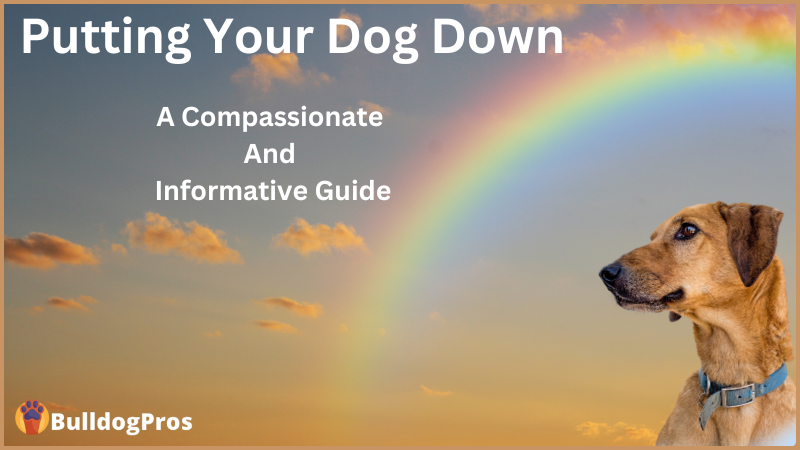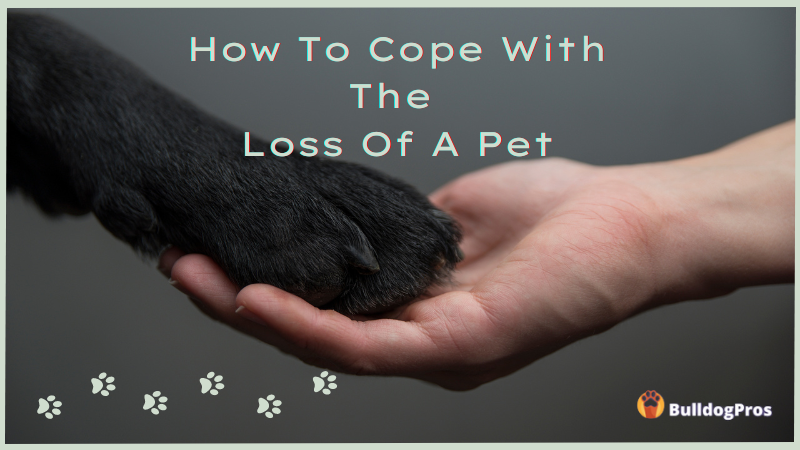Losing a beloved furry companion is undoubtedly one of life’s most heart-wrenching experiences. The decision to put your dog down, although emotionally challenging, is often a compassionate act to alleviate their suffering. In this comprehensive guide, I will provide you with the essential information and guidance you need when considering this difficult choice. As we navigate the delicate topic of “Putting Your Dog Down,” I hope to offer solace, understanding, and practical advice to help you make informed decisions during this emotionally overwhelming time.
Video: Putting Your Dog Down
Understanding the Decision
Assessing Quality of Life
Determining the right time to say goodbye to your furry companion requires a careful evaluation of their quality of life. Keep a watchful eye for signs of pain, suffering, and declining health. Changes in appetite, mobility, and behavior can indicate that your dog may be experiencing discomfort. Ongoing chronic illnesses or severe injuries can also impact their overall well-being.
Seeking Professional Advice
It’s essential to consult with a veterinarian or veterinary specialist to navigate this difficult decision. These professionals bring expertise in assessing your dog’s condition, providing prognosis information, and discussing available options.
Making the Decision as a Family
Involving all family members (appropriately aged) in the decision-making process can provide a sense of unity during this challenging time. Arrange a family meeting to openly discuss the situation, allowing each member to express their thoughts and emotions. Ensure that everyone feels heard and respected. The collective decision-making process can help bring a sense of closure and shared responsibility.
Practical Considerations of Putting Your Dog Down
Choosing the Right Time and Place
Deciding on the right time and place for euthanasia is an important consideration. Some pet owners prefer the comfort of their dog’s familiar surroundings, while others opt for a veterinary clinic. Consider your dog’s overall stress levels in different environments. Create a calm and peaceful atmosphere, minimizing any unnecessary stressors during their final moments.
Legal and Financial Matters
While navigating the emotional aspects of euthanasia, it’s essential to be aware of the legal and financial aspects as well. Discuss the costs associated with euthanasia, cremation, and burial options with your veterinarian. Additionally, research local laws and regulations regarding pet euthanasia and aftercare. Understanding these factors will help you make informed decisions while dealing with the administrative aspects.
Understanding the Process
The process of putting a dog down, also known as euthanasia, involves a humane and compassionate procedure to end a pet’s life peacefully and without pain. It is typically carried out by a veterinarian or under their supervision. Here are the key steps involved:
- Consultation and Consent: The first step is to have a discussion with your veterinarian about your dog’s condition, quality of life, and the option of euthanasia. The veterinarian will explain the procedure, answer any questions you may have, and obtain your informed consent.
- Preparation and Sedation: To ensure a calm and stress-free experience, the veterinarian may administer a sedative to your dog. This helps relax them and makes the process more comfortable. The sedative is usually given through an injection.
- Administration of Euthanasia Solution: Once your dog is sedated and relaxed, the veterinarian will administer the euthanasia solution. This solution typically contains a barbiturate drug, which induces a painless and peaceful passing.
- Monitoring and Aftercare: During the procedure, the veterinarian will monitor your dog’s vital signs, ensuring they remain peaceful and comfortable throughout. After your dog has passed away, you can choose to handle their remains as per your personal preference. Options include cremation, burial, or having the veterinarian handle the arrangements. Some people choose to have the ashes returned to them.
It’s important to note that the process may vary slightly depending on the veterinarian and local regulations. Your veterinarian will guide you through the specific details and address any concerns you may have. They are there to ensure a compassionate and respectful experience for both you and your beloved pet.
Please remember that discussing the process of euthanasia with a veterinarian directly is crucial, as they can provide the most accurate and comprehensive information tailored to your specific situation.
Aftercare and Coping
Dealing with Grief and Guilt
The emotional toll of euthanizing a dog can be overwhelming, often accompanied by feelings of grief and guilt. Remember that it is normal to experience these emotions.
Coping with the grief of losing a beloved pet takes time and varies from person to person. Allow yourself to grieve and honor your dog’s memory in your own way.
Engaging in self-care activities, such as journaling, creating a memorial, or engaging in hobbies that bring you comfort, can also help during the grieving process. Consider creating a memorial or tribute to celebrate your dog’s life. This can include planting a tree, crafting a photo album, or making a donation to a pet-related charity.
Seek support from friends, family, or pet loss support groups who understand the unique bond between humans and animals. Consider reaching out to a grief counselor or therapist who specializes in pet loss if you find it challenging to cope with your emotions.
How Long Do You Grieve A Dog?
There is no set timeline for how long one should grieve the loss of a beloved pet. The grieving process for a dog can vary greatly from person to person. It is a deeply personal experience, and everyone copes with grief in their own way and at their own pace.
Some individuals may find that their initial intense grief subsides after a few weeks or months, while others may take much longer to come to terms with their loss. It’s important to allow yourself the time and space to grieve and process your emotions.
Remember that the bond you had with your dog was unique, and it’s natural to experience a range of emotions, including sadness, loneliness, and even anger. Be patient with yourself and seek support from friends, family, or pet loss support groups who can provide understanding and comfort during this difficult time. Again, if the grieving process becomes overwhelming, consider reaching out to grief counseling or support groups for additional assistance.
Over time, the pain of the loss may lessen, but it’s not uncommon to have moments of sadness or to remember your dog fondly even years later. Grief is a personal journey, and it’s important to honor your own process and give yourself permission to heal in your own time.
Considering a New Companion
At some point, you may contemplate welcoming another furry friend into your life. However, it’s important to take time to heal and reflect on your emotional readiness. When you feel ready, researching different breeds or adoption options can help you find the right companion.
FAQs
Is it a good idea to put my dog down?
Deciding whether to put your dog down is a deeply personal and difficult decision. It’s important to consult with a veterinarian who can assess your dog’s overall quality of life.
Signs that may indicate it’s time to consider euthanasia include severe and chronic pain, loss of appetite, inability to perform basic functions, uncontrollable symptoms, and a diminished joy in life. Ultimately, the decision should prioritize your dog’s well-being and quality of life.
Is it normal to feel guilty about putting my dog down?

Yes, it is completely normal to experience feelings of guilt when considering or going through with euthanasia. As a responsible and loving pet owner, it’s natural to question whether you are making the right decision.
Remember that you are acting in the best interest of your dog’s welfare and preventing further suffering. It can be helpful to discuss your feelings with a supportive friend, family member, or even a professional counselor who can provide guidance and reassurance during this emotional time.
Should you stay with your dog when put to sleep?
Whether to stay with your dog during the euthanasia process is a personal choice. Some pet owners find comfort in being present to provide support and reassurance to their beloved companion in their final moments. Being there can help you feel more connected and allow you to say your final goodbyes.
However, it’s important to consider your own emotional well-being as well. Witnessing the process can be challenging and distressing for some individuals. If you feel that you may not be able to handle the emotional intensity, it’s perfectly acceptable to entrust your dog’s care to the veterinarian and say your goodbyes beforehand. Discussing your preferences with your veterinarian will help ensure a respectful and compassionate experience for both you and your dog.
Additional Reading
Conclusion
As I conclude this compassionate and informative guide on “Putting Your Dog Down,” I sincerely hope that I have provided you with the support and understanding you need during this difficult journey. Remember, the decision to say goodbye to your beloved canine companion is deeply personal, and it is crucial to prioritize their well-being above all else. By considering the physical and emotional factors outlined in this guide, consulting with trusted professionals, and drawing strength from the memories and love you shared, you can navigate this challenging process with compassion and grace.
While the pain of losing a cherished dog is profound, take solace in the fact that you made a selfless decision to end their suffering. Your dog’s life was filled with love and care, and their memory will forever be engraved in your heart. Allow yourself to grieve, seek support from loved ones, and honor the bond you shared. In time, may you find comfort in the knowledge that you provided your loyal companion with a peaceful and dignified farewell.
Remember, every dog is unique, and the circumstances surrounding each individual case may vary. This guide aims to provide general information and support but should not substitute professional advice. Always consult with a veterinarian or an animal healthcare professional for specific guidance tailored to your dog’s needs.
Would you like to share any memories of your beloved pet? Please comment below.



